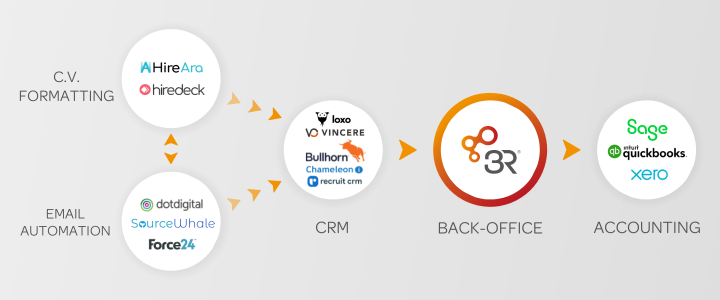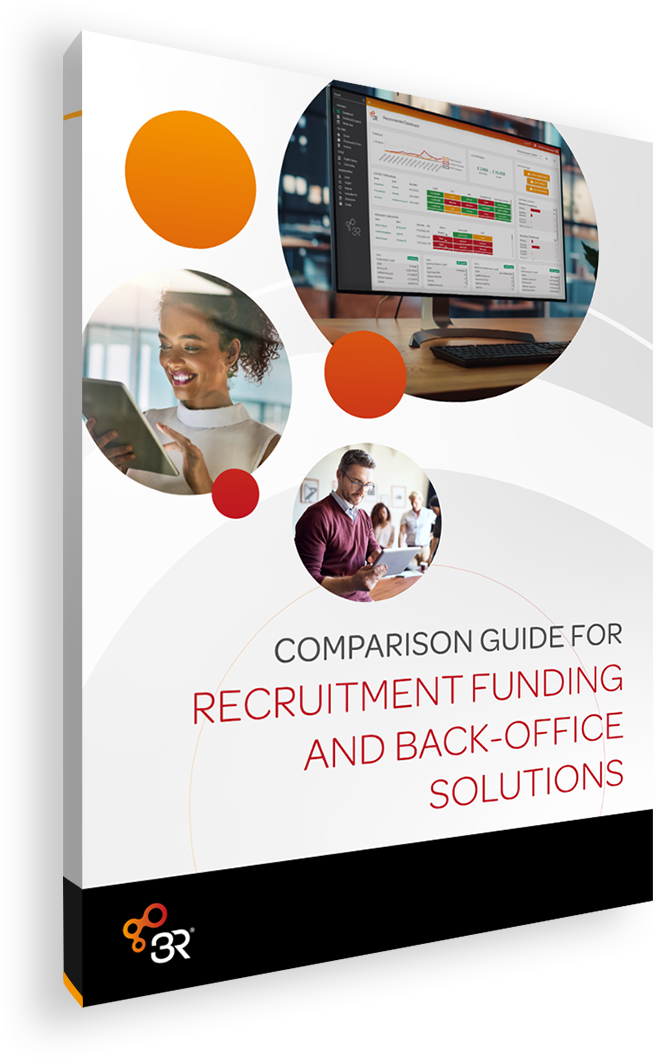Essential Tech for Recruitment Agencies

 When you start running a recruitment agency, it doesn’t take long until you realise that essential recruitment software is key to streamlining processes, maximising efforts and ensuring your business runs efficiently. Across front-end tools for candidate management and marketing to back-end solutions supporting with payroll compliance, client invoicing and financial reporting – there’s a lot out there!
When you start running a recruitment agency, it doesn’t take long until you realise that essential recruitment software is key to streamlining processes, maximising efforts and ensuring your business runs efficiently. Across front-end tools for candidate management and marketing to back-end solutions supporting with payroll compliance, client invoicing and financial reporting – there’s a lot out there!
This blog, written in partnership with Branded by Aquila, will go over the five pieces of technology that are essential for recruitment agencies: a CRM, email automation, CV formatting, back-office platform and accounting software. How you use these tools will depend on the size of your agency, what growth stage you are in and where you are in your recruitment marketing efforts, but we consider them essential because of their overall effect on the efficiency of your business, your brand reputation, scalability and key selling points.
1. Maximise the Benefits of Your CRM Recruitment Software
2. Email Automation as a Recruitment Tool
3. Standardised CV Formatting Through AI and Recruitment Software
4. The Power of a Unified Back-Office System in Recruitment
5. Preparing for Digital Tax With Your Accounting System

1. Maximise the Benefits of Your CRM Recruitment Software
A CRM for recruitment agencies should be your one source of truth. It’s where you build and use your data. This is a fundamental software for recruitment because it streamlines processes, as long as it’s utilised properly and consistently across the board, and feeds into various marketing efforts (which we’ll touch on later).
With the cost of LinkedIn licences, and their expected future increases, many recruitment agencies need to be building a CRM that is their primary source of truth. This means that any additional data that’s gathered through secondary tools should make its way onto the CRM. Having everyone working from one data source that’s up to date protects the investment of your business and promotes genuine growth.
Now’s the time for both leaders and recruiters to map out what data they need in their CRM. This exercise is also useful to highlight what data you might also be lacking. Data-driven recruitment allows you to make smarter, more strategic decisions about candidate sourcing and client engagement.
Leverage Data in Your Recruitment Tech for Better Results
A prime example is using this data to feed into email automations. Successful email automation for recruitment is based upon the quality of your data and the ability to segment your audience. This gives you much more control over how your audience engages with your content. If you’re thinking ahead about how the data you’re gathering will feed into your email campaigns and data automation, recruiters can start to populate a CRM system with a good coding process. The value recruiters then place on building out data in your CRM increases significantly.
So what data fields should you focus on? We’re not talking about the standard first name, company name and email address, as this is the bare minimum you need. When mapping out how you’re going to use the data you gather, start to think about incorporating fields such as organisation size, location, skills, salary. Why? Because the more data you have, the easier it can be for teams to engage with prospects at a more meaningful level.
If you’re capturing company size, recruiters can start to sort candidates based on how they would fit into an organisational structure at a particular company. With locational data, this can help in sourcing candidates within a certain radius of a base location. This process removes the transactional recruiter approach and pivots it towards the more sustainable long term relationship based approach.
Streamline Internal Processes
Thorough data gathering in your CRM can support reporting with a view to appraisals. Measuring and reporting is the key to essential business growth, so why not align data input with company objectives? You can already measure how many contacts someone has added to the system and how long vacancies take to fill, but the key is measuring the metrics that will improve specific areas of the business.
The more informed you are through your use of data, the better decisions you’re able to make. For example, if you set a target of adding 25 clients to your CRM a month, you can make this more structured to achieve a measurable outcome. These 25 clients should be fully coded to support marketing’s objectives of increasing qualified leads through email automation. This then supports the company’s objective of increasing revenue through new business by 20%.
The point is, the more structured you are with your use of data and your CRM, the more effectively you can measure your output and achieve the goals you need to as a business.
2. Email Automation as a Recruitment Tool
When it comes to email automation, this is often crucial for businesses to speak to more people at once. Having said that, there’s various considerations before you venture down this path. In order to ensure maximum return from your investment, businesses should consider both the size of their business and the size of their data set, as well as their capacity to create and optimise automations.
| Email Automation | CV Formatting | CRM | Back Office Platform | Accounting Software | |
| Smaller Agency >>> |
|
Y | Y | Y | |
| Growing Agency >>> | Y | Y | Y | Y | Y |
Small Business Strategy
If you’re a smaller business at the start of its marketing and data journey, there are more lightweight tools that might be more beneficial for you. You can use these to test and learn by using a single recruiter or division, while continuing to build data out on other desks. An outsourced marketer would most likely support a recruiter or small recruitment team in creating workflows, reviewing performance and suggesting changes.
Before you embark on email automation as a small business, you need to first consider if you’re in a position to do so. If your data isn’t ready, you have no assets, value added content or your brand is inconsistent, you should put this off for the meantime. You’ll know when you’re ready to explore mass outreach.
Larger Business Strategy
When it comes to larger businesses, it could be more cost effective to use a mass email marketing tool. This way, you can also make better use of your data at scale. Ultimately, this would likely require heavier investment in terms of a marketing resource, as the tech is more comprehensive lending itself to an email marketing specialist. The trade-off is having a bigger ‘email machine’ that you can get more results out of from lapsed clients and client advocacy to large nurture journeys and NPS surveys.
However, you should be mindful when looking at how much data you have. Big numbers don’t always mean quality data or useful coding to support segmentation. The larger and older a database becomes, the more susceptible it is to dirty data. In order for your email automations to be successful, your CRM needs to be correct and up-to-date.
You can learn more about segmentation and its many uses in our blog about Marketing Qualified Lead nurture journeys.

3. Standardised CV Formatting Through AI and Recruitment Software
Gaining and having complete control over the CVs that you send to clients is beneficial in so many ways. Not only this, but you can save hours by having this step automated. By using a CV formatting tool, you're able to meet multiple objectives for recruiters and from a branding perspective.
Benefits for Recruiters
Many recruiters get frustrated with the hours spent formatting CVs into something which is presentable for a client. The frustration can also vary depending upon which sector they’re working with. Professionals from the creative industry tend to be dealing with more images, while those in STEM industries tend to come across more credentials and accreditations. Wouldn’t it be nice if all CVs were formatted for you?
Formatting CVs into branded templates is important, but so is making sure recruiters can get on the phone and carry on with BD. For anyone familiar with HireAra, templates can be created across the business, allowing for different versions, such as anonymous, with a cover letter or division-specific. Recruiters are then able to reclaim those hours as the AI tool pulls the CV information into a branded template for you.
For anyone using Bullhorn, HireAra can be integrated under its own tab within the candidate view, enabling you to complete this work without leaving Bullhorn. The ability to save a CV directly within Bullhorn also allows businesses to streamline processes. It can save time for the next person when viewing the candidate’s profile.
HireAra is also championing AI in recruitment through its ability to generate an AI profile summary, which can be generated and pinned as a note within the candidate profile. If anyone wants a quick overview before opening their CV, or contacting the candidate. All of this saves considerable amount of time in a recruiter’s day.
Benefits for Brand and Marketing
In terms of uniformity across CVs, the most obvious benefit is ensuring brand consistency and standardisation across the board. There’s nothing more frustrating than spending hours on curating brand messaging over different channels, such as the website, social media, and sales collateral, only for the client to receive a poorly formatted CV later down the line.
With a CV formatting tool, all the hard work is done for you. It doesn’t matter who picks up the job as you’ll know everything will be formatted the exact same and your messaging will be clear.
In some instances, when you send out speculative CVs via email, this could be the client’s first impression. In a highly competitive market, every element of that first impression counts and, more broadly, supports your brand positioning. This is where you can use template designs to your advantage.
CVs can be formatted with these tools to include key messaging in the header and footer, which can help to communicate key areas of your value proposition or a division’s activities. This might include details of an event you’re attending, your CSR roadmap, or simply a link to your terms. Making the most of these tools allows you to be transparent in your communication and outperform your competitors.

4. The Power of a Unified Back-Office System in Recruitment
In the fast-paced world of recruitment, efficiency and accuracy are key to success. This should be seen across front-end activities, but a well-oiled back-end operation is also essential to growth and success. A back-office system serves as the backbone of an agency’s operations, managing crucial administrative tasks such as contractor timesheets and approvals, payroll processing, invoicing, compliance management, and credit control activities. While these functions are essential for smooth day-to-day operations, handling them manually or across multiple systems can be time-consuming, complex, and prone to errors.
By implementing a single, unified back-office platform, recruitment agencies can streamline these processes, reduce administrative burdens, and improve overall efficiency. The knock on impact will improve contactor and client experiences and strengthen your brand reputation.
Centralising payroll, invoicing, and compliance within one system not only minimises errors but also provides full visibility into cash flow and financial management, helping agencies better control their lines of finance. Additionally, a back-office system offers real-time insights into contractor timesheets and perm-hire statuses, ensuring accurate payments and seamless contractor coordination.
Beyond operational efficiency, a well-integrated back-office system allows recruiters to focus on what they do best—sourcing top talent and building strong client relationships. By eliminating unnecessary administrative hurdles, agencies can drive business growth, enhance service delivery, and remain competitive in an increasingly demanding industry.
Key components include:
- Timesheet and Expense Software: Facilitates quick recording and approval of contractor hours and expenses, reducing manual workload.
- Payroll Software: Manages complex contractor payments, ensuring timely and accurate disbursements.
- Invoicing Software: Automates billing processes, minimising errors and accelerating cash flow.
- Compliance and Risk Software: Ensures adherence to legal standards, reducing potential liabilities.
- Reporting Software: Provides insights into agency performance, aiding strategic decision-making.
Integrating your back-office system with your CRM and accounting software ensures seamless data flow across platforms and improved data integrity. Agencies can also benefit from outsourced back-office support, including credit control, compliance management, and financial administration, helping to maintain a steady cash flow and reduce financial risks.
5. Preparing for Digital Tax With Your Accounting System
Every recruitment agency, regardless of size, requires an efficient accounting system to accurately track its financial transactions. Maintaining up-to-date digital records is not only a smart business practice but a necessity, especially with HMRC’s ongoing push towards 'Making Tax Digital'.
While the full rollout of this initiative was initially aimed for 2020, it has been extended to 2027, meaning agencies must be prepared for the transition. By adopting reliable accounting software like Xero, Sage, or QuickBooks, agencies can ensure they’re ready for the eventual digital tax requirements, keeping their financial records accurate and compliant.
Whether your accounts are managed in-house or by an outsourced professional, utilizing trustworthy accounting software will help prevent any last-minute compliance issues and streamline your financial operations.
Get the Right Recruitment Tools for Your Business
We hope this has been as informative as it has been helpful. Simply ensuring that you have the essential tech that works for you isn’t enough though. You need to use it to its full potential to really reap the benefits of improved efficiencies and a reduction in hours spent on tedious admin.
To re-cap, a well-structured CRM should be your single source of truth, supporting automation, business development, and data-driven decisions. Email automation helps nurture candidates and clients but relies on well-organized data. AI-powered CV formatting saves time while ensuring brand consistency. A unified back-office system streamlines payroll, invoicing, compliance, and financial management, improving efficiency and cash flow. Accounting software ensures accuracy and tax compliance keeping you prepared for HMRC’s ‘Making Tax Digital’ rollout.
By integrating these tools and leveraging outsourced support for tasks like credit control, agencies can reduce admin, improve client and contractor experiences, and focus on business growth.
About Branded by Aquila
Branded by Aquila provides brand, marketing, and consultancy solutions to drive revenue, attract talent, and accelerate growth - delivering results aligned to your business goals.
With 10+ years in recruitment marketing and MBA/CIM credentials, they create tailored strategies that meet C-suite expectations and empower recruitment marketers. Their expertise helps recruiters stand out in a competitive landscape by applying proven B2B methods.

